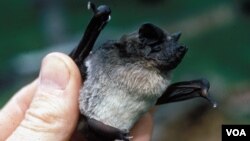Researchers believe that bats are the source of the virus behind the current Ebola epidemic in West Africa, but a new study points to a different species than the fruit bats implicated in earlier outbreaks.
The Ebola virus usually jumps from its animal host to humans through contaminated bushmeat — hunters bring home an infected fruit bat, or an ape or antelope that contracted the virus. While bats are unaffected carriers of Ebola, it is deadly for other forest dwellers.
In earlier outbreaks, large mammals were also affected. But when researchers from Berlin's Robert-Koch Institute arrived in Guinea in April to investigate the growing epidemic, they found no decline in the wildlife population. So they turned their attention to another source of transmission, theorizing that the virus was coming directly from its host, bats.
Dr. Fabian Leendertz, who led the team, said they focused on hunters and their efforts to catch and kill fruit bats, until they learned that the first victim of the current Ebola outbreak was a 2-year-old boy.
"That changed our point of view,” he recalled. “I thought, 'We have to also look at children and their behaviors.' And that was sort of the breaking point, because the children don't hunt the fruit bats. But what they do in these villages in general, they hunt these small insect-[eating] bats with sticks under the roof and in trees. Wherever they find them, they will hunt them and kill them and roast them over the fire."
Through interviews in the boy's village of Meliandou, the researchers learned that local children often played in a large, hollow tree that was home to a large colony of Angolan free-tailed bats. Locals were quoted as saying the tree caught fire in March, causing a "rain of bats" to escape.
The presence of hundreds of the mouse-sized creatures presented the possibility of massive exposure to the virus.
Leendertz said the situation was similar to one in 2008, in which a tourist in Uganda visited the Python Cave, where a colony of bats roosted, and contracted the Marburg virus, which is related to Ebola. There is growing evidence, but no proof, that fruit bats harbor filoviruses, which cause the two hemorrhagic fever diseases.
Writing in EMBO Molecular Medicine, Leendertz said the findings expanded the range of possible reservoirs for Ebola.
"What we want to say with this article is that because we don't know what the exact reservoir is and what the virus does in the reservoir and how it's circulating, we should keep an open view and also include in the investigations insectivorous bats and not focus only on fruit bats, as most teams have done in the past," he said.
Starting with the young boy in a small Guinean village, Ebola has spread to more than a half-dozen countries, infected more than 20,000 people and killed more than 7,800.









